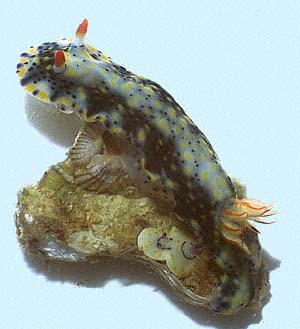
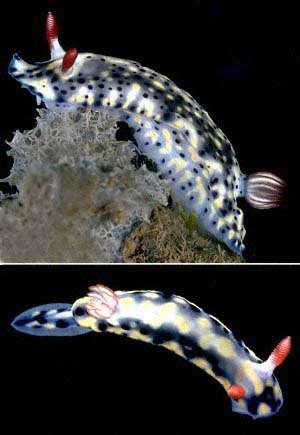
Hypselodoris infucata
(Ruppell & Leuckart, 1830 or 1831)
Order: NUDIBRANCHIA
Suborder: DORIDINA
Family: Chromodorididae
DISTRIBUTION
Tropical Indo-West Pacific. [Also Mediterranean - lessepsian migrant]
PHOTO
UPPER: Entrance to harbour, Dar es Salaam, Tanzania, July 1974. 50mm long alive.
MIDDLE: Adult animal on half eaten sponge Dysidea? sp. Koumac, New Caledonia, October 1993. 42mm long alive.
LOWER: Juvenile animal, Noumea, New Caledonia, Oct, 1988
PHOTOS: Bill Rudman.
Two Australian species, are possibly regional forms of Hypselodoris infucata. They are Hypselodoris saintvincentius found in South Australia, and Hypselodoris obscura from New South Wales and southern Queensland.
Throughout the Indo-West Pacific various names have been given to this species depending on the relative size of the yellow and blue spots. As is shown here, juveniles often have no dark blue specks and their yellow patches are relatively large.
References:
• Rudman, W.B. (1984d) The Chromodorididae (Opisthobranchia: Mollusca) of the Indo-West Pacific: a review of the genera. Zoological Journal of the Linnean Society 81: 115-273.
• Rudman, W.B. (1977) Chromodorid opisthobranch Mollusca from East Africa and the tropical West Pacific. Zoological Journal of the Linnean Society 61: 351-397.
• Rüppell, E. & Leuckart, F.S. (1830 or 31) Neue wirbellose Thiere des Rothen Meeres. Atlas zu der Reise im nördlichen Afrika von Eduard Rüppell. Brunner, Frankfurt am Main. 23-50, pls 7-12.
Rudman, W.B., 1998 (November 28) Hypselodoris infucata (Ruppell & Leuckart, 1830 or 1831). [In] Sea Slug Forum. Australian Museum, Sydney. Available from http://www.seaslugforum.net/find/hypsinfu
Related messages
Hypselodoris from Larak Island, Iran
May 4, 2010
From: Mahdi Moradi Och Tape
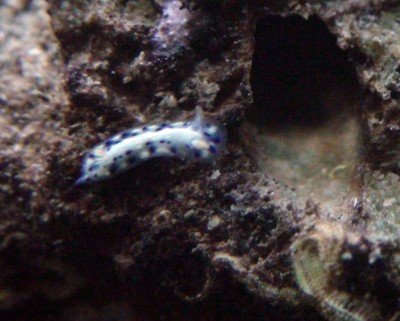
In duration my researches on Coral Reef in Persian Gulf I did find these species on coral Reef bed in Larak & Qeshm Island, and I need to your guidance about identification and biology information of this species?
Locality: Larak Island - Bandar Abbas , 4-8 m , Iran , Persian Gulf , 5 January 2009, Rocky Bed . Length: 1cm. Photographer: Omid Alizade .
Best Regard
Mahdi Moradi
biologymoradi@gmail.com,
Moradi, M., 2010 (May 4) Hypselodoris from Larak Island, Iran. [Message in] Sea Slug Forum. Australian Museum, Sydney. Available from http://www.seaslugforum.net/find/23598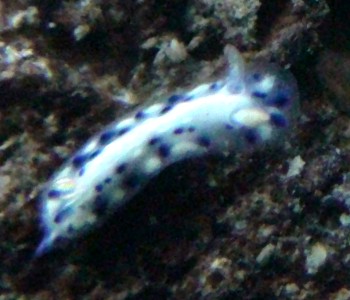
Dear Mahdi,
From the background, I suspect your animal was small and almost certainly a juvenile. There are a number of species of Hypselodoris with dark blue spots but until they have grown enough to develop their other colours it is not possible to be 100% sure of their identity. I suspect your animal is Hypselodoris infucata.
Best wishes,
Bill Rudman
Hypselodoris infucata from the Gulf of Kutch, India
May 25, 2009
From: Apte Deepak
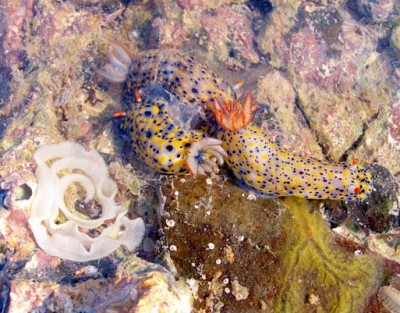
Concerning message #19463:
Dear Dr. Bill
I was keen to know if Hypselodoris infucata can occur in high densities seasonally. On 26th March we have encountered hundreds of individuals in shallow reef of Gulf of Kutch, Narara. After a point, I gave up the count.
Locality: Narara, Exposed reef, Gujarat, India, Arabian Sea, 26th April 2009. Length: 50- 70 mm. Photographer: Deepak Apte.
Deepak Apte
Bombay Natural History Society, India
spiderconch@gmail.com
Apte, D.A., 2009 (May 25) Hypselodoris infucata from the Gulf of Kutch, India. [Message in] Sea Slug Forum. Australian Museum, Sydney. Available from http://www.seaslugforum.net/find/22388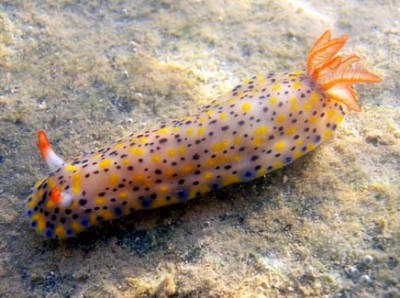
Dear Deepak,
I have never seen this species in large numbers, but I have seen quite a few other species of chromodorids in large numbers, and others have also witnessed large populations. These large populations are usually short-lived and are apparently the result of the presence of a good supply of their preferred food sponge and for those with veliger larvae, a successful settlement of the veligers.
Best wishes,
Bill Rudman
Re: Hypselodoris infucata from the Mediterranean Sea
March 4, 2009
From: Henrik Personn

Concerning message #9208:
Hello to all!! I have taken a picture of the Hypselodoris infucata on the North Coast of Cyprus. The area where I found it has only few sponges. It was a night dive and the H. infucata was active. So, is this a new species or only a migrant which found its way to North Cyprus?
Locality: Zeyko Diving Site / Girne, 15m, Turkish Republic of North Cyprus, editerranean, 16 August 2007, Rocks - algae. Length: 15 mm. Photographer: Henrik Personn.
Henrik Personn
henrik.personn@gmx.de
Personn, H., 2009 (Mar 4) Re: Hypselodoris infucata from the Mediterranean Sea. [Message in] Sea Slug Forum. Australian Museum, Sydney. Available from http://www.seaslugforum.net/find/22309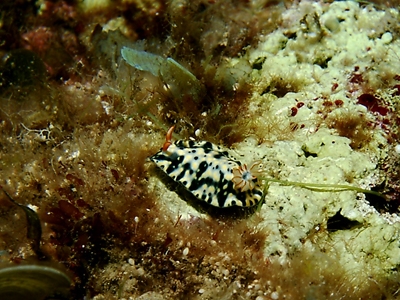
Dear Henrik,
As well as the message you refer to, there are a couple more messages on the Forum reporting H. infucata from the Mediterranean [message #20988; #9145]. I am not sure if there are records from northern Cyprus, but it is quite a well-known Indo West-Pacific visitor to the Mediterranean via the Suez Canal. We call these animals lessepsian migrants.
Best wishes,
Bill Rudman
Re: Hypselodoris saintvincentius from South Australia
July 29, 2008
From: Yahia Mokhtar
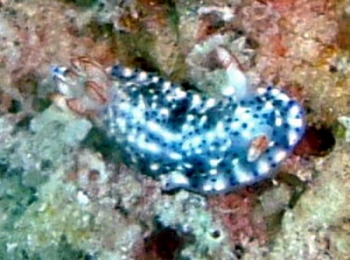
Concerning message #14629:
While diving the Persian Gulf yesterday on MV-Hannan wreck, 34 nm off Abu-Dhabi island, and photographing a cluster of seven Chromodoris annulata, I noticed a very tiny black Nudibranch, barely seen, of about 3-4 mm length, and 1 mm width.
I took several pictures with Macro & zoom, and here are the best photos after enlargement, where you can compare my thumb to the nudibranch.
Compared it to Dennis's picture in South Australia in August 26, 2005, and there is a big similarity. Hopefully no Great White Sharks in the area, could this be a Hypselodoris saintvincentius?
Locality: MV-Hannan Wreck, 12m, Abu-Dhabi, United Arab Emirates, Persian Gulf (South), 26 July 2008, wreck on 20 m depth. Length: 3-4 mm. Photographer: Yahia Mokhtar.
Yahia Mokhtar
yahia@adma.ae
Mokhtar, Y., 2008 (Jul 29) Re: Hypselodoris saintvincentius from South Australia. [Message in] Sea Slug Forum. Australian Museum, Sydney. Available from http://www.seaslugforum.net/find/21748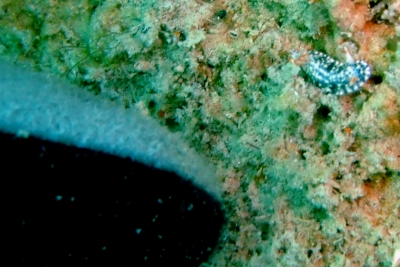
Dear Yahia,
As I mention in the earlier message, H. saintvincentius and H. infucata are difficult to distinguish. It is possible that H. saintvincentius will prove to be a southern Australian 'form' of the widespread H. infucata. Your animal is a juvenile Hypselodoris infucata.
Your mention of large C. annulata and small H. infucata together reminds me of my photo [#15058] of the opposite. More importantly, perhaps you could check your photos of the cluster of C. annulata. Hopefully they show the sponge this species eats more clearly than in your other message [#21749 ]?
Best wishes,
Bill Rudman
Hypselodoris infucata - feeding, egg ribbon
June 4, 2008
From: Teresa Zuberbühler
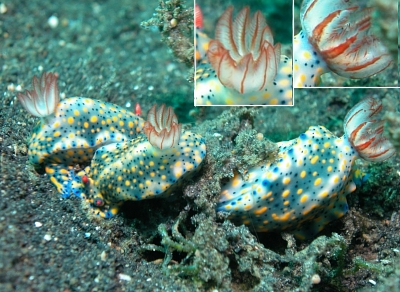

Concerning message #17447:
Dear Bill
I send you 2 photos of a Hypselodoris infucata laying eggs to add to the photos of this nudibranch mating (Photos taken in Bali and Sulawesi).
While looking through my photos I also found a good photo of Hypselodoris infucata feeding on a sponge. I send you a large photo so you might be able to make out which species of sponge it is.
You can see, that the nudbranchs were really "flocking" to that place - there were even more there then the 3 specimens on the photo, perhaps six or so, if I remember correctly and they were all really buring their mouthparts in the sponge! (Photo taken in Sulawesi)
Locality: Lembeh, 15-20m, Sulawesi, Indonesia, Pacific, July 2004 / 2006 / 2007, Muddy. Photographer: Teresa (Zubi) Zuberbühler.
Greetings
Zubi
www.starfish.ch
webmaster@starfish.ch
Zuberbühler, T., 2008 (Jun 4) Hypselodoris infucata - feeding, egg ribbon. [Message in] Sea Slug Forum. Australian Museum, Sydney. Available from http://www.seaslugforum.net/find/21614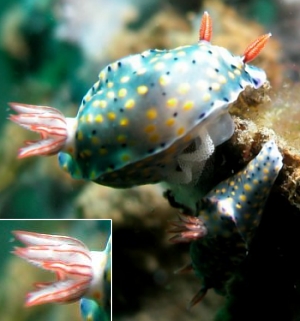
Dear Zubi,
Thanks for these interesting photos. While the upper two photos are of H. infucata, I am pretty sure the lower photo is of H. kanga. If you look at earlier messages from Mike Krampf [message #18901] and Bob Whorton [message #14188] you will see I discuss how these two similarly coloured species can be distinguished by the shape and coloue of their gills. In your lower photo you can see the gills are triangular in cross-section, which means the outer edge has two red lines, instead of only one in H. infucata. Usually we can see white or yellow spots inside the red lines in H. kanga. In your upper photo, showing the group feeding, some of the gills on the animal on the right have a double red line on the basal half. I suspect all the animals in that photo are H. infucata, but the double line is a bit of a puzzle - perhaps it is related to the larger size of this animal.
Thanks for the feeding photo. Unfortunately the sponge they are eating is well hidden under a layer of sand. I presume the sponge will be a species of Dysidea, which is the sponge they are normally found eating. From your photos it seems both H. infucata and H. kanga have almost identical egg ribbons. We have a number of other photos of the egg ribbon of H. kanga, but surprisingly no others of the widespread H. infucata. If anyone has photos of its egg ribbon they would be a useful confirmation.
Best wishes,
Bill Rudman
Hypselodoris infucata from mediterranean coast of Israel
April 2, 2008
From: Udi Hakim
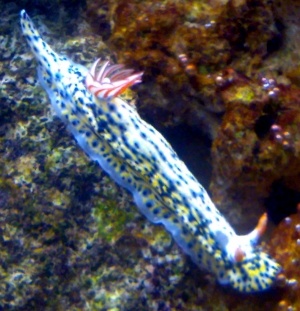
Hi,
I recently found a nice noticed a great looking sea slug on a mediterranean reef near the coast of Israel, can someone ID it?
2 meters, Israel, mediterranean , 10 October 2007. Length: 5 cm long. Photographer: Udi Hakim.
Udi Hakim
udi_hakim@hotmail.com
Hakim, U., 2008 (Apr 2) Hypselodoris infucata from mediterranean coast of Israel. [Message in] Sea Slug Forum. Australian Museum, Sydney. Available from http://www.seaslugforum.net/find/20988Dear Udi,
This is Hypselodoris infucata. It is interesting because it is one of a growing number of Indian Ocean species which are finding their way into the Mediterranean through the Suez Canal. [Have a look at the Lessepsian migrants Page for further information. This species has been living in the Mediterranean for some years.
Best wishes,
Bill Rudman
Hypselodoris infucata from New Caledonia
August 30, 2007
From: Jean-François Hervé
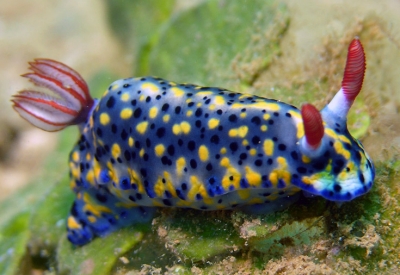
Dear Bill;
Another one I'm having difficulty with. I can't choose between Hypselodoris infucata and H. obscura. Thank you for your help.
Locality: Noumea-Ouémo, 9 m, New Caledonia, Pacific Ocean, December 06, sandy bottom or algae. Length: 35 mm. Photographer: Jean-François Hervé.
Best Wishes
Jean-François
jfherve@free.fr
Hervé, J.F., 2007 (Aug 30) Hypselodoris infucata from New Caledonia. [Message in] Sea Slug Forum. Australian Museum, Sydney. Available from http://www.seaslugforum.net/find/19124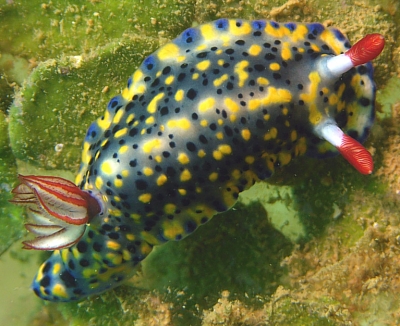
Dear Jean-François,
I can understand your hesitation with these two species. I really am not sure if H. obscura is a 'good' species or a regional variant of H. infucata. Whatever the final decision, I think we will be able to say that H. obscura is found only on the subtropical and warm temperate coasts of eastern Australia. So my feeling is that animals from New Caledonia should be indentified as H. infucata.
Best wishes,
Bill Rudman
Hypselodoris saintvincentius or H. infucata
July 13, 2007
From: Brad Cox
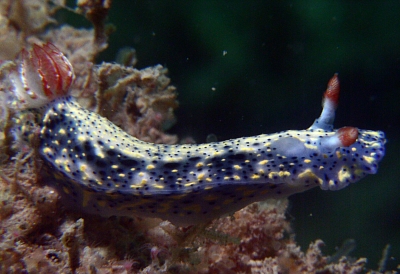
Bill
I have noticed with interest the discussions on the Hypselodoris saintvincentius. I originally believed this animal to be H. infucata. Is this Hypselodoris saintvincentius or H. infucata?
I have also noted in message #14263 that you indicate that H. saintvincentius is only known known only from South Australia and southwestern Western Australia which has confused me a little as Carnarvon is not in the southwest but further north.
Locality: One Mile Jetty Carnarvon , 6-7 meters, Western Australia , Indian Ocean , 3 February , Muddy sandy Bottom. Length: 20-30mm. Photographer: Brad Cox .
Brad Cox
outbackcoastdive@westnet.com.au
Cox, B., 2007 (Jul 13) Hypselodoris saintvincentius or H. infucata. [Message in] Sea Slug Forum. Australian Museum, Sydney. Available from http://www.seaslugforum.net/find/20117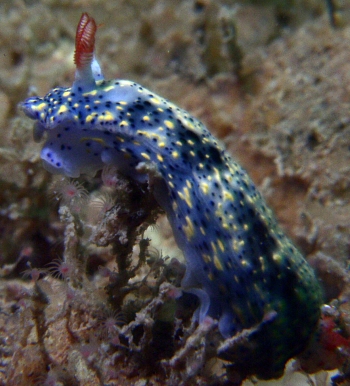
Dear Brad,
I am afraid identifying species is not always 'black & white'. Hypselodoris infucata is a widespread species in the tropical Pacific and Indian Oceans. In southeastern Australia a very similarly coloured species, H. obscura, has been described and from South Australia a third species, H. saintvincentius, has been recognised which has also been found in the southwestern part of Western Australia. Although I can confidently recognise animals from Sydney Harbour as H. obscura, and those from South Australia as H. saintvincentius, I'm afraid that as we move up the east and west coasts of Australia I find it very difficult to determine where these southern species are replaced by the tropical H. infucata. Johnson & Valdes (2001) suggest they are different but every time I see animals like yours I wonder if we really know what's going on. One character I thought was a good indicator of H. saintvincentius was how the red edging to the gills in that species branched out along the edges of the individual gill leaflets, while in H. infucata the red edging was unbranched, but as message #9221 shows, even tropical animals can have this feature. I think I would identify your animal as H. infucata, mainly because of where you found it. It is definitely not in temperate waters, which seems to be the main defining difference in these species. If H. saintvincentius does occur that far north then it seems to me the premise on which these two southern species is justified will be very hard to sustain.
- Johnson, R. F. and Valdés, A. (2001) The Hypselodoris infucata, H. obscura and H. saintvincentius species complex (Mollusca, Nudibranchia, Chromodorididae), with remarks on the genus Brachyclanis Ehrenberg, 1831. Journal of Natural History 35: 1371-1398.
Best wishes,
Bill Rudman
Color variations of Hypselodoris infucata from Tulamben
May 2, 2007
From: Mike Krampf
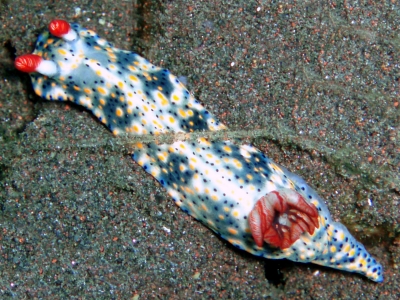
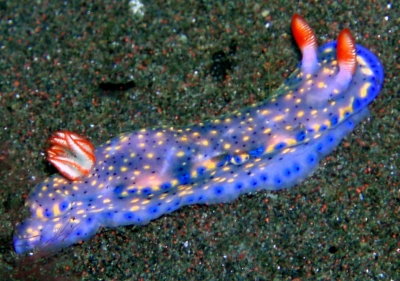
Dear Bill,
I thought I'd share these pictures of Hypselodoris infucata since they show different color variations of the species. All were taken in Tulamben, Bali.
Locality: Tulamben, 45 ft, Bali, Indonesia, Java Sea, 7 October 2006, Sandy bottom. Length: 3 cm. Photographer: Mike Krampf.
Mike
mtkrampf@yahoo.com
Krampf, M., 2007 (May 2) Color variations of Hypselodoris infucata from Tulamben. [Message in] Sea Slug Forum. Australian Museum, Sydney. Available from http://www.seaslugforum.net/find/18901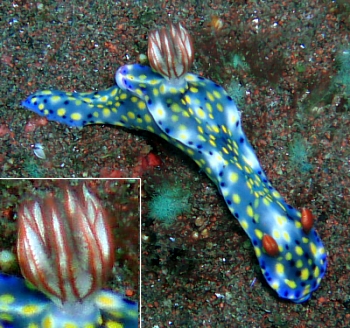
Dear Mike,
Thanks for these photos. The upper two photos are H. infucata, but the one alongside is most probably Hypselodoris kanga. In Hyspelodoris infucata the gills are what we call 'simple' because they are essentially a two dimensional leaf with a red line along the internal and external edge. If you look at the gills in the lower animal, they are triangular in cross-section which means there are three edges to each gill, one on the inside and two on the outside, each with a red line. Usually in H. kanga there are a series of white or yellow spots in the space between the outer red lines of each gill. I can't see any sign of them in this animal but the triangular cross-section suggests that this is H. kanga.
Best wishes,
Bill Rudman
Re: Hypselodoris infucata from the Gulf of Kutch, India
May 2, 2007
From: Binyamin Koretz
Concerning message #19388:
Dear Bill,
Because the gill structures of this animal are a bit triangular rather than simple as is usual with Hypselodoris infucata, I was wondering whether it might be Hypselodoris kanga? Admittedly, there are no yellow spots on the gills, though.
best regards
Binyamin
books@booksinternational.com
Koretz, B., 2007 (May 2) Re: Hypselodoris infucata from the Gulf of Kutch, India. [Message in] Sea Slug Forum. Australian Museum, Sydney. Available from http://www.seaslugforum.net/find/19463Dear Binyamin,
Although the gills have a slight widening at the base of the outer side, it doesn't look like the gills of Hypselodoris kanga. More importantly this animal does not have the relatively high profile of that species. It's hard to put it into words but some species of Hypselodoris have a fairly muscular and high body, such as H. bullocki and others have a lower profile with thinner, more fleshy, skin, such as H. maritima and H. emma. I would consider H. kanga to have a high profile, while this animal from the Gulf of Kutch is one with a low profile.
Best wishes,
Bill Rudman
Hypselodoris infucata from the Gulf of Kutch, India
February 9, 2007
From: Arpit Deomurari
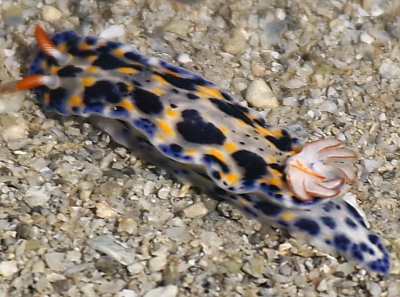

I found this beautiful looking seaslug today morning on a sandy shallow water near Narara Reef in Gulf of Kutch, Gujrat, India. I would like experts to get this beauty identified.
Locality: Narara Island, Gulf of Kutch, shallow water 10 cm, Gujarat, Gulf of Kutch, Arabian Ocean, 03, february 2007, Intertidal sandy area. Length: 1.5 inches. Photographer: Arpit Deomurari.
Arpit Deomurari
deomurari@gmail.com
Deomurari, A., 2007 (Feb 9) Hypselodoris infucata from the Gulf of Kutch, India. [Message in] Sea Slug Forum. Australian Museum, Sydney. Available from http://www.seaslugforum.net/find/19388
Dear Arpit,
It's always good to get more photos of animals from along the northern part of the Indian Ocean because I still think we have things to learn about colour variation and speciation of these species. This is probably Hypselodoris infucata, which in the western Indian Ocean seems to have a more spotted colour pattern than in the Pacific, where the colours seem to diffuse into one another. However what strikes me about your animal is its similarities to H. sagamiensis, a species known only from Japan. In fact if the large blue-black patches were slightly smaller I would almost be convinced it was H. sagamiensis.
Best wishes,
Bill Rudman
Re: Hypselodoris infucata feeding
October 31, 2006
From: Bruce Wilkie


Concerning message #17448:
Hi Bill,
I had a look through my files to see if I had better shots of Hypselodoris infucata feeding. I think these photo`s show the food sponge a bit better.
Upper photos: Locality: Flat Rock North Stradbroke Island, 10-14 metres, Queensland Australia, Pacific ocean, 13th July 2006, rocky reef with sponges, hard & soft corals . Length: 25mm. Photographer: Bruce Wilkie.
Lower photo: Flat Rock, 11 May 2006. Photographer: Bruce Wilkie
With regards to the ID of these animals I am still unsure about the difference between H. infucata and H. obscura. You are the expert, and I have renamed my file on these animals. I have about 40 of these animals on file and when I get time I will have to go through carefully and see if I have wrongly ID any of them.
Many Thanks,
Bruce Wilkie.
brucedwilkie@yahoo.com.au
Wilkie, B., 2006 (Oct 31) Re: Hypselodoris infucata feeding. [Message in] Sea Slug Forum. Australian Museum, Sydney. Available from http://www.seaslugforum.net/find/17805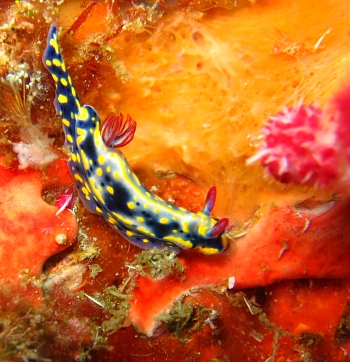
Dear Bruce,
The pinkish sponge in the upper photo is a dysideid and so could well be the food of this species. However I can't see any obvious food sponge in the lower photo, although its possible the yellowish sponge is a dysideid, but I can't be sure.
Concerning the differences between H. obscura and H. infucata. All I can say is the external differences are subtle and if they are indeed distinct species, your animals are H. infucata.
Best wishes,
Bill Rudman
Re: Hypselodoris infucata feeding
September 12, 2006
From: Bruce Wilkie
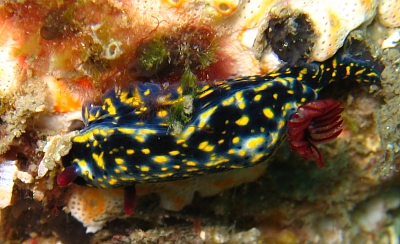
Concerning message #15878:
Hi Bill,
Here are some photos of Hypselodoris obscura on a possible food sponge.
Locality: Shag Rock, Point Lookout, North Stradbroke Island., 10 metres, Queensland Australia, Pacific ocean, 12 August 2006, rocky reef with sponges, hard & soft corals . Length: 25mm. Photographer: Bruce Wilkie.
I hope they help.
Many thanks,
Bruce Wilkie.
brucedwilkie@yahoo.com.au
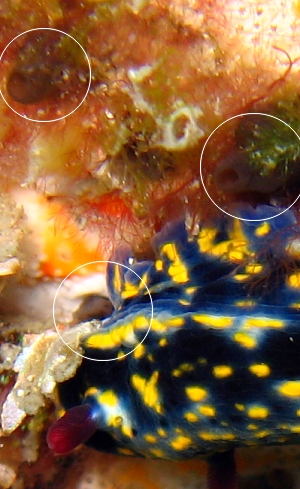
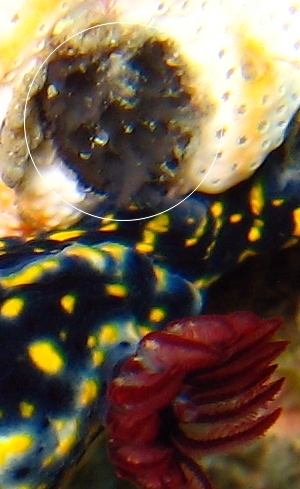
Dear Bruce,
Firstly, I think this is the widespread Indo-West Pacific species H. infucata. I have been unsure about two regional Australian species, Hypselodoris saintvincentius found in South Australia, and Hypselodoris obscura from New South Wales and southern Queensland, but Johnson & Valdés (2001) consider they have found differences. I must say that they each look a little different externally to the practised eye, but it is hard to put the differences in words. H. infucata usually can be distinguished from H. obscura in having dark patches down each side of the mantle. These sometimes merge, as in your animal, to a broad dark band down each side.
Concerning its food. I am sure it is feeding, but as often hapens the sponge it is intersted in his almost completely overgrown by the a white & pinkish colont of what looks like an ascidian. In the two close-ups I have ringed the few parts of the greyish sponge colony on which I suspect it is feeding. It is probably a dysideid, but I can't see enought to be sure.
-
Johnson, R. F. and Valdés, A. (2001) The Hypselodoris infucata, H. obscura and H. saintvincentius species complex (Mollusca, Nudibranchia, Chromodorididae), with remarks on the genus Brachyclanis Ehrenberg, 1831. Journal of Natural History 35: 1371-1398.
Best wishes,
Bill Rudman
Hypselodoris infucata mating
September 12, 2006
From: Bruce Wilkie
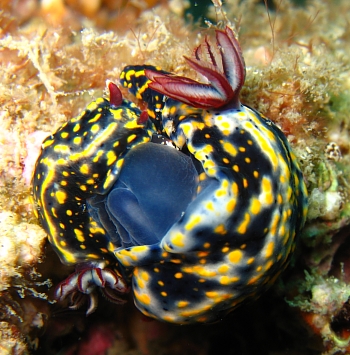
Hi Bill,
Found these H. obscura mating, thought you might like them for your records. Over the last two weeks or so, these animals have been quite abundant.
Locality: Shag Rock, Point Lookout, North Stradbroke Island., 7 metres, Queensland Australia, Pacific ocean, 12 August 2006, rocky reef with sponges, hard & soft corals . Length: 25mm. Photographer: Bruce Wilkie.
Many Thanks for all your help in identifying different animals over the past months.
Bruce Wilkie.
brucedwilkie@yahoo.com.au
Wilkie,B, 2006 (Sep 12) Hypselodoris infucata mating. [Message in] Sea Slug Forum. Australian Museum, Sydney. Available from http://www.seaslugforum.net/find/17447Dear Bruce,
Thanks for the photo. As I said in your other message [#17448], I am pretty sure these are H. infucata.
Best wishes,
Bill Rudman
Hypselodoris infucata in Red Sea
July 19, 2006
From: Martina Balzarova
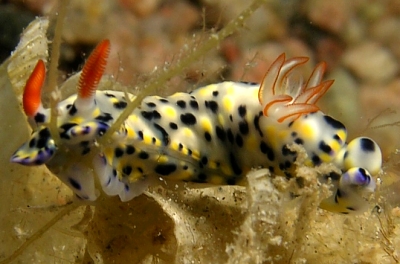
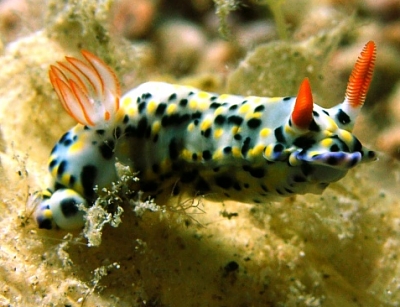
Hello,
I found Hypselodoris infucata at Dahab on the Sinai Peninsula. It was on a sandy and grass bottom in shallow water. It was on some sea-weed. After a few minutes there some fish appeared and they attacked the nudibranch - I dont have a picture because my camera didn't have enough batteries.
Locality: Dahab- Lighthouse, 1,5m, Egypt, Red sea, 11 July 2006, grass and sandy bottom. Length: 35mm. Photographer: Martina Balzarova
Have a nice day
Best wishes,
Martina
balzarova@volny.cz
Balzarova, M., 2006 (Jul 19) Hypselodoris infucata in Red Sea. [Message in] Sea Slug Forum. Australian Museum, Sydney. Available from http://www.seaslugforum.net/find/17161Dear Martina,
Thanks for the photos. What you don't mention is what happened to the nudibranch after it was attacked by the fish? Did it survive? Did the fish decide it tasted bad? I would be interested to know, as we have few observations of 'natural' interactions between fish and chromodorids.
Best wishes,
Bill Rudman
Hypselodoris infucata ? from Vietnam
July 10, 2006
From: Mike Krampf
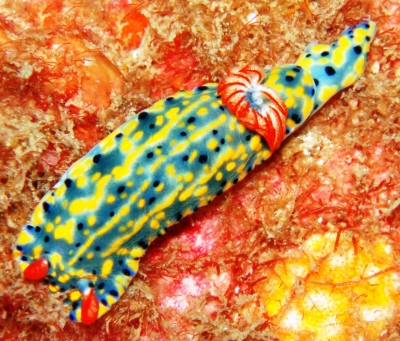
Can you ID this one for me? Is it Hypselodoris infucata? I just got back from diving Vietnam and don't see a lot of pics from there. I have about a dozen pics of nudibranches from there so please let me know if you want to see them to help with your geographic distribution data on species.
Locality: Dive Site - Three Kings off Whale Island, 45 ft, North of Nha Trang, Vietnam, South China Sea, 28 June 2006, Rock Pinnacle. Length: 4-5 cm. Photographer: Mike Krampf.
Thanks,
Mike
mtkrampf@yahoo.com
Krampf, M., 2006 (Jul 10) Hypselodoris infucata ? from Vietnam. [Message in] Sea Slug Forum. Australian Museum, Sydney. Available from http://www.seaslugforum.net/find/17040Dear Mike,
Yes this is a colour variant of H. infucata. Concerning other photos from Vietnam. Any from there would be a valuable addition to our knowledge. We know very little about that fauna, apart from 2 papers published in 1956 on some opisthobranchs from Nha Trang by Jean Risbec. I look forward to seeing your photos
Best wishes,
Bill Rudman
Hypselodoris infucata color variation from the Red Sea
February 13, 2006
From: Binyamin Koretz
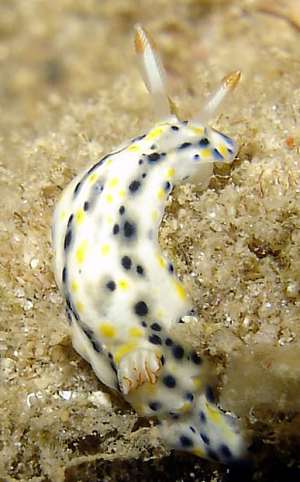
Dear Bill,
Hypselodoris infucata is a commonly seen nudibranch here in Eilat with a large, stable population, most typically colored as in the photos posted earlier by Oren Lederman (msg #13791) and Ilan Ben-Tov (msg #9491 ). We've regularly seen an annual cycle, generally speaking, beginning with the appearance of juveniles in the early winter through mature mating adults in the spring and possibly into summer.
Locality: Eilat, Malibu Beach, 2m, Israel, Red Sea (Gulf of Eilat), 04 February 2006 (night), coral rubble. Length: ca 1.5 cm. Photographer: Binyamin and Shulamit Koretz
The attached photo (probably sub-adult) shows an unsual color variation that I've never seen before at any development stage. You can see that the lower two-thirds of the rhinophore lamellae are pale rather than the usual red-orange. In parallel, the gill edges are also colored only in the uppermost area.
Best regards
Binyamin
binyamin@koretz.net
Koretz, B., 2006 (Feb 13) Hypselodoris infucata color variation from the Red Sea. [Message in] Sea Slug Forum. Australian Museum, Sydney. Available from http://www.seaslugforum.net/find/15795Dear Binyamin,
This is indeed a strange colour variation, but if you compare it with Ilan Ben-Tov's photos the biggest difference is the absence of the background blue colour. However the wat the gills and rhinophores only have orange at the tips is very strange as rhinophore colour is one part of the colour pattern we can usually rely on to be constant. I guess you should add this to your list of things to keep an eye on.
Best wishes,
Bill Rudman
Hypselodoris infucata & H. kanga
July 4, 2005
From: Bob Whorton
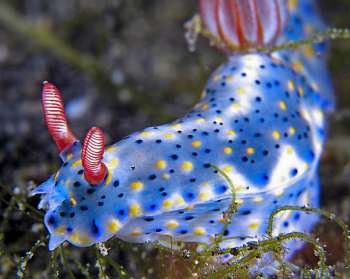
Hi Bill,
Came across this pretty Hypselodoris in Lembeh last year. First time I'd seen the blue variety. Plenty of the green version tho'
Locality: Jahir dive site, Sulawesi, Lembeh Strait, Indonesia. Depth: 12 m. Length: 6 cm. September 2004. Black Sand. Photographer: Bob Whorton
Bob
drbob.whorton@btinternet.com
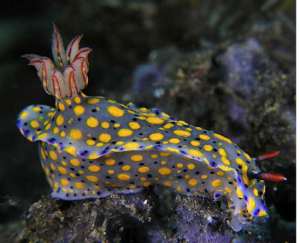
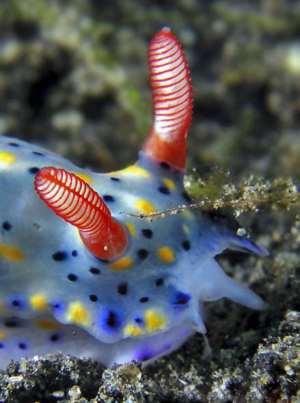
Dear Bob,
The bright blue animal is a colour form of Hypselodoris infucata. Have a look at Sabine Noack's message [#9508] for the same colour form from Bali. The reason I am considering it a colour form of H. kanga are the triangular patterns at the edge of the mantle. If you look at other photos on the Forum of more typical colour forms of H. infucata [see message #9133] you will see darker green or blue diamond shaped marks at the edge of the mantle. I think the triangular marks in your animal are the outer half of the diamond pattern.
The green animal you mention [lower left photo] is a different species, Hypselodoris kanga, which can be distinguished by the shape and colour of the gills. I have discussed this in more detail in a separate message [#14186]. It is possible that H. infucata has evolved this blue colour form to mimic H. kanga much as occurs in the red-spotted chromodorids of southeastern Australia, but we would need a lot more information to demonstrate that.
Best wishes,
Bill Rudman
Hypselodoris infucata from Khor AlAdaid, Qatar
July 1, 2005
From: Iain Macdonald
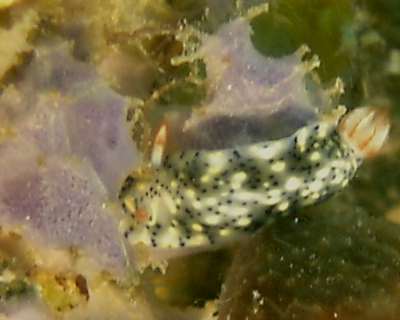
Dear Bill,
Here is a photo of what I have identified from the Fact Sheet is Hypselodoris infucata.
Locality: Khor Al Adaid, Qatar, Persian Gulf. Depth: 8 -15 m. Length: 10 mm. 12 Feb 2005. In coral community, feeding on sponge in picture. Photographer: Iain Macdonald
Hopefully you can confirm.
Iain Macdonald
dr_iamacdonald@yahoo.co.uk
Macdonald, I.A., 2005 (Jul 1) Hypselodoris infucata from Khor AlAdaid, Qatar. [Message in] Sea Slug Forum. Australian Museum, Sydney. Available from http://www.seaslugforum.net/find/14143Dear Iain,
Nice to get another record of its food sponge, a species of Dysidea.
Best wishes,
Bill Rudman
Hypselodoris infucata from South Africa
June 28, 2005
From: David Holloway
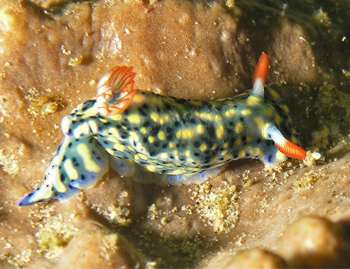
Dear Bill
Is this a juvenile Hypselodoris rudmani?
Locality: Sodwana Bay, North Coast KwaZulu-Natal, South Africa. Indian Ocean. Depth: 10 m. Length: 12 mm. 30 December 2004. Inner Reef top. Photographer: David Holloway
Regards
David Holloway
davidh@idc.co.za
Holloway, B.D., 2005 (Jun 28) Hypselodoris infucata from South Africa. [Message in] Sea Slug Forum. Australian Museum, Sydney. Available from http://www.seaslugforum.net/find/14100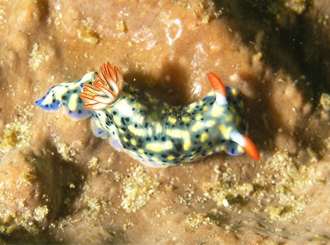
Dear David,
This is Hypselodoris infucata. Hypselodoris rudmani is basically translucent, with a reticulate pattern of opaque white, sometimes reduced to whitish spots. There are small black specks/spots scattered over the mantle - but very scarce or absent in the mid region. There is also a row of larger dark blue spots around the mantle edge, which is translucent clear. The gill pockets have unusually raised sheaths, and the rhinophore clubs are orange red. The simple gills are translucent with a thin orange line along the inner and outer edges - sometimes also with some white pigmentation.
Best wishes,
Bill Rudman
Hypselodoris infucata mating?
May 18, 2005
From: Oren Lederman
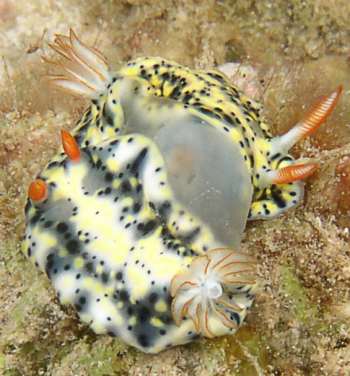
Hi Bill,
Found these two Hypselodoris infucata last weekend. Don't know for sure, but it seems like they are mating (what else could it be?). Can you confirm ?
Locality: The "Dekel" beach, Israel, Red Sea. Depth: ~24 meters. Length: ~2-3 cm. 12 May 2005. Photographer: Oren Lederman.
Oren Lederman
lederman@bigmail.co.il
Lederman, O., 2005 (May 18) Hypselodoris infucata mating?. [Message in] Sea Slug Forum. Australian Museum, Sydney. Available from http://www.seaslugforum.net/find/13791Dear Oren,
Yes these two are mating
Best wishes,
Bill Rudman
Hypselodoris infucata from the Red Sea
April 4, 2003
From: Ilan Ben-Tov
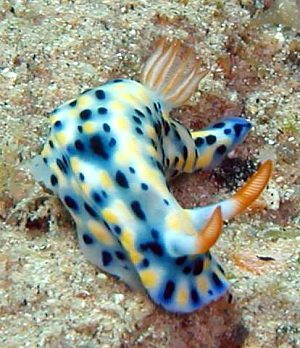

Dear Bill,
Here are some photos of Hypselodoris infucata from Eilat, Red Sea. Depth 5m. 22 March 2003
Ilan Ben-Tov
ilanbt@gilat.com
Tov, I.B., 2003 (Apr 4) Hypselodoris infucata from the Red Sea. [Message in] Sea Slug Forum. Australian Museum, Sydney. Available from http://www.seaslugforum.net/find/9491
Dear Ilan,
Thanks for these photos. Hypselodoris infucata was first described from the Red Sea over 170 years ago, so it is one of the first chromodorids to be named. It is good to get some photos of typical Red Sea specimens. I have posted a scan of the original painting alongside [Rüppell, E. & Leuckart, F.S. (1830 or 31) - Pl 10, fig. 3].
• Rüppell, E. & Leuckart, F.S. (1830 or 31) Neue wirbellose Thiere des Rothen Meeres. Atlas zu der Reise im nördlichen Afrika von Eduard Rüppell. Brunner, Frankfurt am Main. 23-50, pls 7-12.
Best wishes,
Bill Rudman
Hypselodoris infucata from the Red Sea
March 26, 2003
From: Ilan Ben Tov
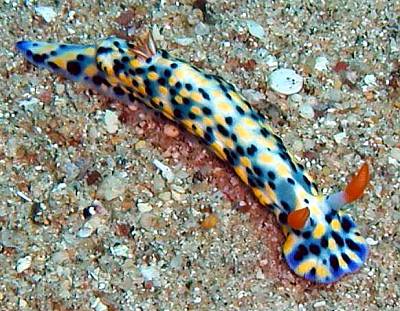
Dear Bill
This was taken at at Eilat in the northern Red Sea.
Ilan Ben Tov
ilanbt@gilat.com
Ben Tov, I., 2003 (Mar 26) Hypselodoris infucata from the Red Sea. [Message in] Sea Slug Forum. Australian Museum, Sydney. Available from http://www.seaslugforum.net/find/9458Dear Ilan,
This is a particularly startling colour form of Hypselodoris infucata. This colour form looks quite similar to Hypselodoris kanga, but in H. infucata the gills are simple, while in H. kanga they are triangular in cross-section, and have a series of yellow spots on the outer face.
Best wishes,
Bill Rudman
Hypselodoris infucata from Burma (Myanmar)
March 8, 2003
From: Orhan Aytur
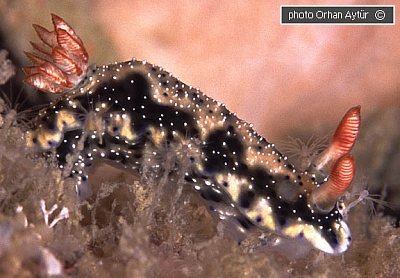
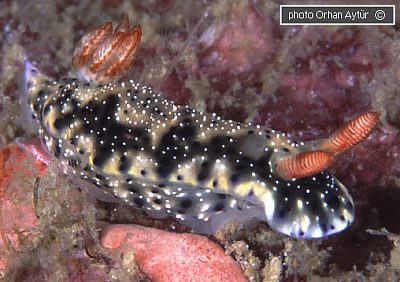
Hi Bill,
I saw the recent post by Danny Van Belle on Hypselodoris infucata from Thailand. I am sending two photogrphs of the same species from Burma (Myanmar), some 200 km north of where Danny took his photographs. The Andaman Sea variety seems to be a little different than the H. infucata from the Mediterranean that I sent earlier; the ones in Andaman have these small white raised dots on their bodies.
Cheers,
Orhan Aytur
aytur@ee.bilkent.edu.tr
Aytur, O., 2003 (Mar 8) Hypselodoris infucata from Burma (Myanmar). [Message in] Sea Slug Forum. Australian Museum, Sydney. Available from http://www.seaslugforum.net/find/9221Dear Orhan,
Those little white specks are in fact skin glands which can release white secretions. I assume they are a secondary mantle glands, with a similar function to those around the mantle edge. They are not always present which makes me think they have a cyclic activity, perhaps filling after feeding? If you look at the related species Hypselodoris obscura, you will see that they are present in most of the photos of that species on the Forum.
Best wishes,
Bill Rudman
Re: Hypselodoris infucata from the Mediterranean Sea
February 15, 2003
From: Baki Yokes
To accompany Orhan Aytur's message, although it is a well-known lessepsian species, Hypselodoris infucata is rarely seen in Turkish waters. It is found on, or around the sponge species of Dysidea, but these sponges are mostly found in North Aegean, Marmara and in the Black Sea, which is probably too cold for H. infucata. Therefore the distribution of H. infucata is limited to a few locations in the Mediterranean coast of Turkey, where sponges are plenty. It will not be a surprise to see this species in Fethiye, Marmaris, Tekirova or in Iskenderun Bay.
Best wishes
Baki
bakiyokes@turk.net
Thanks Baki,
It would be inetersting to know if the Dysidea it feeds on in the Mediterranean is also a lessepsian migrant or a Mediterranean native.
Best wishes,
Bill Rudman
Hypselodoris infucata or H. kanga?
February 12, 2003
From: Danny Van Belle
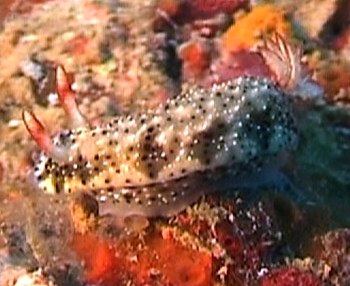
Hi Bill,
You remember the pictures of Hypselodoris kanga which were very similar to Hypselodoris zebrina!
Here's another one from the same divesite which to my opinion could also be H. kanga but looks completely different to the other ones! You can also see them regulary on this divesite 'the boonsung wreck'
Divesite: Boonsung wreck - Tap Lamu, west coast of Thailand. Depth: 15m. Length: max 2cm.
Danny Van Belle
dannyvb@hotmail.com
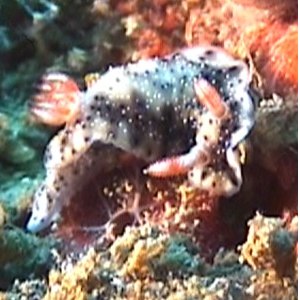
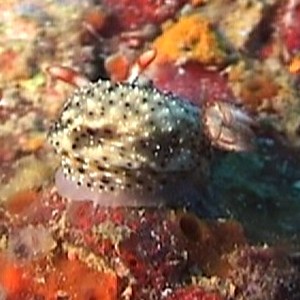
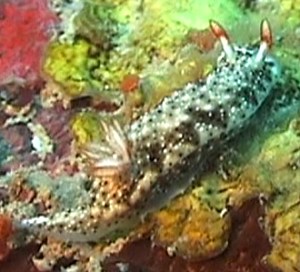
Dear Danny,
This is definitely Hypselodoris infucata. In fact it looks quite like the ones in the message just posted from Turkey. One quite typical feature is the series of dark patches, usually diamond-shaped down each side of the mantle. One simple way to distinguish it from from H. kanga is that in H. kanga the gills are triangular in cross section and the outer face, which is without gill leaflets has a series of yellow spots. In H. infucata the gills are two-sided in cross-section, with a thin red line along the edge.
Best wishes,
Bill Rudman
Hypselodoris infucata from the Mediterranean Sea
February 11, 2003
From: Orhan Aytur
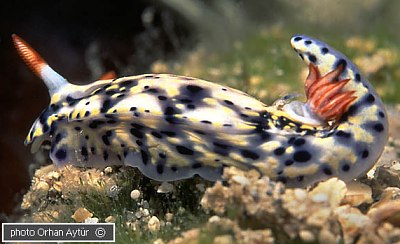
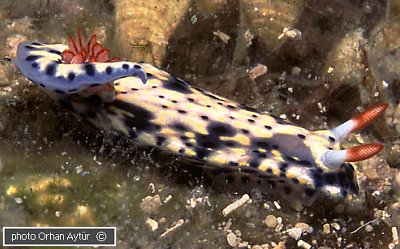
Here are some photographs of Hypselodoris infucata from the Mediterranean Sea. All three photographs are of the same specimen. These photographs were taken near Fethiye, Turkey, in June 2000.
Orhan Aytur
aytur@ee.bilkent.edu.tr
Aytur, O., 2003 (Feb 11) Hypselodoris infucata from the Mediterranean Sea. [Message in] Sea Slug Forum. Australian Museum, Sydney. Available from http://www.seaslugforum.net/find/9145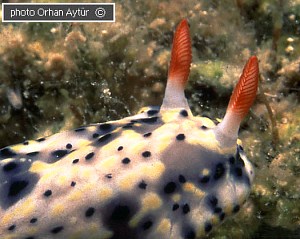
Thanks Orhan,
H. infucata is a well-known lessepsian migrant into the Mediterranean from the Red Sea. It is good to get a photo record of it from there. There seems to be some damage to the mantle around the gills, but it is clearly H. infucata
Best wishes,
Bill Rudman
Hypselodoris infucata from Indonesia
October 19, 2002
From: Sabine Noack
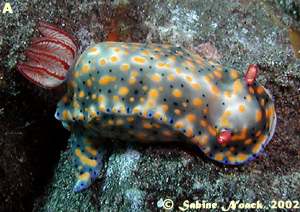
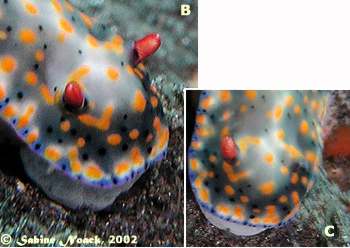
Dear Bill.
The following pictures of a Hypselodoris infucata were taken within a few seconds. The slug was sitting on one of the black stones in shallow water close to the edge of a deeper area of black sand, there were 2 Hypselodoris nigrostriata 2 stones further away, and there was a bit of a surge moving it's gills.
On pictures A (13:39:52) and B (13:40:32) both rhinophores are clearly visible, on picture C (13:40:50) one is missing (possibly pulled in). I didn't touch the animal or manipulate the photos.
Location: Ulami North, Tulamben, East Bali, Indonesia.
Date: 28.9.2002 13:40
Depth: 4 m
Length: 4 cm
Sabine Noack
dive@snoack.de
Noack, S., 2002 (Oct 19) Hypselodoris infucata from Indonesia. [Message in] Sea Slug Forum. Australian Museum, Sydney. Available from http://www.seaslugforum.net/find/9508This is a copy of Sabine's message which is posted on the Nudibranch rhinophore page. I have duplicated this message as it shows an interesting colour variation of Hypselodoris infucata.
Bill Rudman
Hypselodoris infucata from Bintan
August 13, 2002
From: Alice Lee
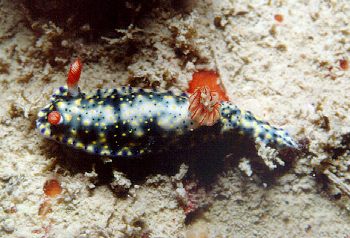
These nudibranch is very small in size but the color captured my eyes. Taken on the Dutch Freighter Wreck, north of Bintan. [Bintan Is., Riau Archipelago, Indonesia - South China Sea]
Depth: 10m
Size: 3cm
Photo taken on 3/August/2002
Regards,
Alice
alee@dlink.com.sg
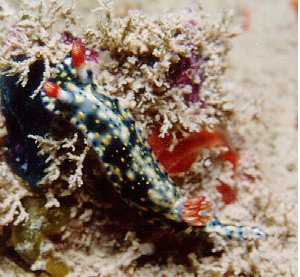

Dear Alice,
This is Hypselodoris infucata
Best wishes,
Bill Rudman
Hypselodoris infucata feeding.
May 4, 2002
From: Mary Jane Adams
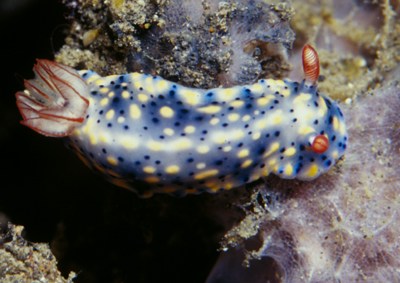
Hi Bill,
I found this Hypselodoris infucata sitting on a pink sponge which it is apparently eating. The slug was about 2cm long. The divesite, Teluk Kembahu is a sand slope with patch reef. Lembeh Strait, Sulawesi, Indonesia. April 9, 2002
Best regards,
Mary Jane
divepng@yahoo.com
Adams, M J., 2002 (May 4) Hypselodoris infucata feeding.. [Message in] Sea Slug Forum. Australian Museum, Sydney. Available from http://www.seaslugforum.net/find/6873Thanks Mary Jane,
It's possibly the same as the sponge in my photo from Koumac, New Caledonia
Bill Rudman
Hypselodoris infucata from Papua New Guinea
January 14, 2002
From: Mary Jane Adams
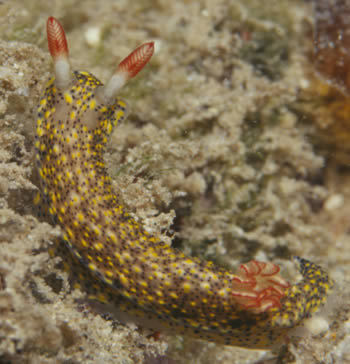
Hi Bill,
This was a new one for me. I believe it is Hypselodoris infucata.
Length: about 25 mm
Depth: 8 meters
Divesite: Old Slipway, Kavieng, New Ireland, Papua New Guinea
Date: Oct. 16, 2001
Best regards,
Mary Jane
divepng@yahoo.com
Adams, MJ , 2002 (Jan 14) Hypselodoris infucata from Papua New Guinea. [Message in] Sea Slug Forum. Australian Museum, Sydney. Available from http://www.seaslugforum.net/find/5929Dear Mary Jane,
Yes this is a form of H. infucata. Sometimes, like in your photo, the yellow and blue marks are very small specks, while in other animals they are quite large spots.
best wishes,
Bill Rudman
Hypselodoris infucata from Red Sea
July 8, 2000
From: Jochen Scholtyssek
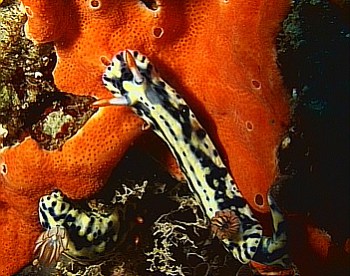
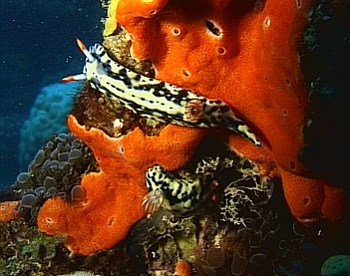
Dear Bill,
Here are some Video-Pictures of another nudibranch from the Red Sea.
April 2000. ROYAL Diving Center, Akaba, Jordan. Depth 15m.
Best wishes,
Jochen Scholtyssek
joscholty@t-online.de
Scholtyssek, J., 2000 (Jul 8) Hypselodoris infucata from Red Sea. [Message in] Sea Slug Forum. Australian Museum, Sydney. Available from http://www.seaslugforum.net/find/2684Dear Jochen,
This is Hypselodoris infucata. It is nice to get photos from the Red Sea, because that is where this species was first found 170 years ago. It is found throughout the Indo-West Pacific and is quite variable in colour, so photos from the Red Sea help us to build up information on its colour variability in the Indian Ocean region.
Best wishes,
Bill Rudman.
Hypselodoris infucata from South Africa
May 10, 2000
From: Valda Fraser

Dear Bill
At last I have found Hypselodoris infucata, or so I think. Please confirm.
Locality: Aliwal Shoal, Umkomaas -15m, south coast KwaZulu-Natal, SOUTH AFRICA
Date: May 2000
Size: 20mm
Regards,
Valda
iti04937@mweb.co.za
Fraser, V., 2000 (May 10) Hypselodoris infucata from South Africa. [Message in] Sea Slug Forum. Australian Museum, Sydney. Available from http://www.seaslugforum.net/find/2373Dear Valda,
Congratulations! Yes it is H. infucata.
Best wishes,
Bill Rudman.
Hypselodoris infucata from Red Sea
July 29, 1999
From: Erwin Koehler
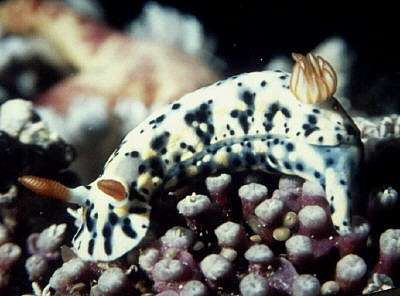
Bill,
this photo by H.-H. Harms (Hamburg, Germany) was made off Dahab, Red Sea, depth 3m in April 1979. Is it Hypselodoris infucata (as I guess) or something else?
Erwin
Medslugs.Koehler@t-online.de
Koehler, E., 1999 (Jul 29) Hypselodoris infucata from Red Sea. [Message in] Sea Slug Forum. Australian Museum, Sydney. Available from http://www.seaslugforum.net/find/1118Dear Erwin,
Yes, it certainly looks like Hypselodoris infucata to me. Good to get a photo from the where it was first described.
Best wishes,
Bill Rudman.
Colour forms of Hypselodoris infucata
November 30, 1998
From: Michael Miller
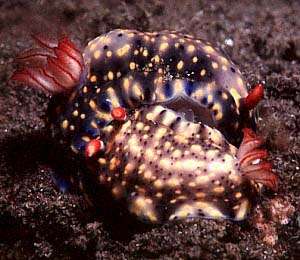
Dear Bill,
Continuing the theme of your reply to Mr. Lumnitzer's message, you will find attached an image of what is believed to be two (2) color forms of Hyselodoris infucata copulating. The picture was taken at Tulamben, Bali, Indonesia during a recent trip. Please feel free to post the image if you find it of interest.
Cheers,
Michael Miller
mdmiller@cts.com
Miller, M.D., 1998 (Nov 30) Colour forms of Hypselodoris infucata. [Message in] Sea Slug Forum. Australian Museum, Sydney. Available from http://www.seaslugforum.net/find/345Thanks Mike,
Its an almost parallel situation to Akos's photo of Hypselodoris obscura mating. The two species are obviously closely related but there seems to be a consistent radula difference with the innnermost tooth of H. obscura being bicuspid while it is tricuspid in H. infucata.
